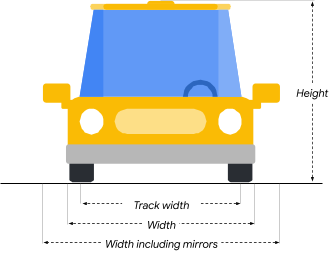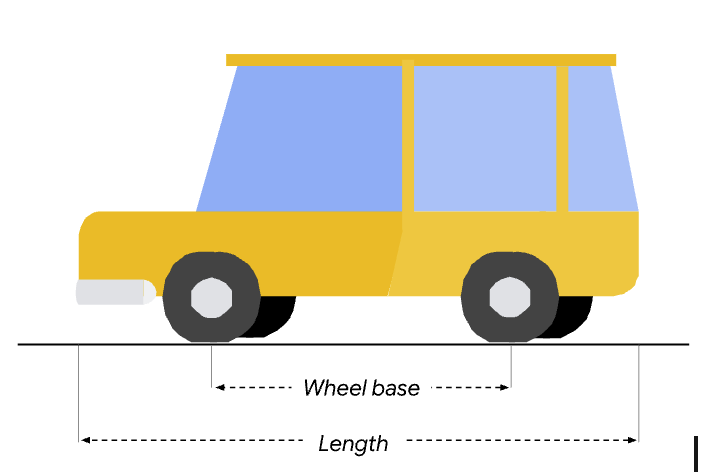Vendor properties
To support partner-specific needs, the VHAL allows vendor properties that are accessed only through system APIs. Use the following guidelines when working with vendor properties:
- Always try to use system properties first, vendor properties should be used as a last resort when none of the system properties feeds your requirement.
- To prevent ecosystem fragmentation, vendor properties must not be used to replicate vehicle properties that already exist in the SDK VehiclePropertyIds. To learn more, see Section 2.5, Automotive Requirements in the CDD.
- Use the following fields to generate the Property ID:
VehiclePropertyGroup:VENDORVENDOR group is used only for vendor properties.VehicleAreaSelect an appropriate Area Type.VehiclePropertyTypeSelect the proper data type. BYTES type allows passing raw data, which is sufficient in most cases. Sending big data frequently through vendor properties can slow down entire vehicle network access. Be careful when adding a big payload.Property IDChoose a unique two-byte ID for vendor property. For example, 0x1234.
- Fill in
VehiclePropConfig.configStringwith a short description of the vendor property. This allows validity check tools to flag the accidental replication of existing vehicle properties. For example, "My custom property for XYZ." - Access through
CarPropertyManager
(for Java components) or through the
libvhalclient(for native). Do not modify other car APIs as doing so can lead to future compatibility issues.
Vendor properties permission
The default permission for any defined vendor properties is
android.car.Car.PERMISSION_VENDOR_EXTENSION. For finer granularity of permission
control, support the SUPPORT_CUSTOMIZE_VENDOR_PERMISSION property. This STATIC
property is read-only, for which its config array specifies the permissions for vendor properties.
The configArray is set as follows (i is an integer starts from 0):
configArray[3 * i]propId, the property ID for the vendor property.configArray[3 * i + 1]An enum inVehicleVendorPermission.aidlto indicate permission to read the property value.configArray[3 * i + 2]An enum inVehicleVendorPermission.aidlto indicate permission to write the property value.
For example, the following config array configures two vendor properties,
vendor_prop_1 and vendor_prop_2, to have the permissions:
vendor_prop_1requiresandroid.car.hardware.property.VehicleVendorPermission.PERMISSION_GET_CAR_VENDOR_CATEGORY_SEATto read,android.car.hardware.property.VehicleVendorPermission.PERMISSION_SET_CAR_VENDOR_CATEGORY_SEATto write.vendor_prop-2requiresandroid.car.hardware.property.VehicleVendorPermission.PERMISSION_GET_CAR_VENDOR_CATEGORY_INFOto read, and is not writable for Android apps.
configArray = { PERMISSION_SET_VENDOR_CATEGORY_SEAT vendor_prop_2, PERMISSION_GET_VENDOR_CATEGORY_INFO, PERMISSION_NOT_ACCESSIBLE }
Vendor properties not in this array take the default vendor permission. When
PERMISSION_NOT_ACCESSIBLE is selected, Android apps can't access the property.
In the example, Android apps can't write a value for vendor_prop_2. Only native
VHAL clients can write to this property.
Advanced driver assistance systems (ADAS)
See ADAS Vehicle Properties.SEAT and STEERING
See SEAT and STEERING_WHEEL properties.
HVAC
You can use the VHAL to control HVAC by setting HVAC-related properties. Most HVAC properties are associated with particular areas in the vehicle, although several are global properties. Sample defined properties include:
| Property | Purpose |
|---|---|
HVAC_TEMPERATURE_SET |
Set temperature per area ID. |
HVAC_POWER_ON |
The power state of the HVAC system per area ID. |
For HVAC properties that are dependent on the power state of the HVAC system, they must be
listed in the HVAC_POWER_ON config array. To see a complete list of HVAC properties,
search for HVAC_* in VehicleProperty.aidl, see
Supported System Properties.
properties.
Rules for mapping non-GLOBAL VehicleArea type HVAC properties to AreaIDs:
Every “area” for a specific VehicleArea type that is affected by the property, must be
included in an area ID for that property. The temperature controllers are assigned to the
seats that they "most influence," but every affected seat must be included exactly once.
The assignment of the center rear seat to the left or right AreaID might seem arbitrary,
but the inclusion of every affected seat in exactly one AreaID ensures that the seats
in the car are all expressed and that a reasonable way to affect each seat is available.
Example 1
A car has two front seats (ROW_1_LEFT, ROW_1_RIGHT) and three back seats
(ROW_2_LEFT, ROW_2_CENTER, ROW_2_RIGHT). There are two temperature control units, one each For
the driver side and the passenger side. A valid mapping set of AreaIDs for
HVAC_TEMPERATURE_SET would be a two-element array:
- ROW_1_LEFT | ROW_2_LEFT
- ROW_1_RIGHT | ROW_2_CENTER | ROW_2_RIGHT
An alternative mapping for the same hardware configuration would be:
- ROW_1_LEFT | ROW_2_CENTER | ROW_2_LEFT
- ROW_1_RIGHT | ROW_2_RIGHT
Example 2
A car has three seat rows with two seats in the front row (ROW_1_LEFT, ROW_1_RIGHT)
and three seats in the second (ROW_2_LEFT, ROW_2_CENTER, ROW_2_RIGHT) and third rows
(ROW_3_LEFT, ROW_3_CENTER, ROW_3_RIGHT). There are three temperature control units, one each for
the driver side, the passenger side, and the rear. A reasonable way to map
HVAC_TEMPERATURE_SET to AreaIDs is a three element array:
- ROW_1_LEFT
- ROW_1_RIGHT
- ROW_2_LEFT | ROW_2_CENTER | ROW_2_RIGHT | ROW_3_LEFT | ROW_3_CENTER | ROW_3_RIGHT
Example 3
A car has two front seats (ROW_1_LEFT, ROW_1_RIGHT) and three back seats (ROW_2_LEFT, ROW_2_CENTER, ROW_2_RIGHT). Suppose the car supports HVAC_AUTO_ON for just the two front seats. A valid mapping set of AreaIDs for HVAC_AUTO_ON would be a single element array:
- ROW_1_LEFT | ROW_1_RIGHT
If HVAC_AUTO_ON had two separate control units for the driver side and passenger
side, an alternative mapping would be a two elements array:
- ROW_1_LEFT
- ROW_1_RIGHT
INFO_EXTERIOR_DIMENSIONS
A vehicle's exterior dimensions are measured in millimeters, as illustrated in Figure 1.


Use the properties described in this table to define a vehicle's exterior dimensions.
| Vehicle property | VHAL field | Description |
|---|---|---|
| Height | int32Values[0] |
Vertical distance between the ground and the highest point on the vehicle. This presumes normally inflated factory wheels. |
| Length | int32Values[1] |
Horizontal distance between the outermost points of the front and rear of the vehicle. |
| Width, excluding mirrors | int32Values[2] |
Horizontal distance between the two outermost points on each side of the vehicle, excluding the side mirrors. |
| Width, including mirrors | int32Values[3] |
Horizontal distance between the two outermost points on each side of the vehicle, including the side mirrors. |
| Wheel base | int32Values[4] |
Distance between the vehicle's center of the front and rear wheels. |
| Track width, front | int32Values[5] |
Distance between the front wheel, measured from the center line of one tire tread to the center line of the opposite tire tread. |
| Track width, rear | int32Values[6] |
Distance between the rear wheel, measured from the center line of one tire tread to the center line of the opposite tire tread. | Curb-to-curb turning diameter | int32Values[7] |
The diameter of the circle made by the outer wheels of the vehicle when making a complete turn with a fully-locked steering wheel. |
European Union general safety regulation compliance
If the vehicle must comply with European Union General Safety Regulation (GSR) requirements
through Android, the property GENERAL_SAFETY_REGULATION_COMPLIANCE_REQUIREMENT must
be supported. An example use case is GSR-ISA (Intelligent Speed Assist) as defined in EU
Regulation 2019/2144. This property is added in AIDL VHAL from Android 13, however, it is
supported in Car Service since the release of Android 12. This property is defined as a read-only
static global integer property, with possible values defined by
GsrComplianceRequirementType enum:
| Name | Value | Description |
|---|---|---|
GSR_COMPLIANCE_NOT_REQUIRED |
0 | GSR compliance is not required |
GSR_COMPLIANCE_REQUIRED_V1 |
1 | GSR compliance is required and the requirement solution version is 1. |
To support this property in HIDL VHAL (in Android 12), vendors must hard-code the property ID.
For example, the following snippet shows how this is supported in the reference HIDL
VHAL
DefaultConfig.h:
{
.config =
{
// GENERAL_SAFETY_REGULATION_COMPLIANCE_REQUIREMENT
.prop = 0x11400F47,
.access = VehiclePropertyAccess::READ,
.changeMode = VehiclePropertyChangeMode::STATIC,
},
// GsrComplianceRequirementType::GSR_COMPLIANCE_REQUIRED_V1
.initialValue = {.int32Values = {1}},
}To support this property in AIDL VHAL (from Android 13), vendors can use the property ID from
VehicleProperty.h and enum from GsrComplianceRequirementType.h. For
example, as in reference AIDL VHAL
DefaultProperties.json:
{
"property": "VehicleProperty::GENERAL_SAFETY_REGULATION_COMPLIANCE_REQUIREMENT",
"defaultValue": {
"int32Values": [
"GsrComplianceRequirementType::GSR_COMPLIANCE_REQUIRED_V1"
]
}
}To read this property from an Android app, use
CarPropertyManager.getIntProperty.
- In Android 13 and higher, use
VehiclePropertyIds.GENERAL_SAFETY_REGULATION_COMPLIANCEas the property ID. - In Android 12, use the hard-coded value of 0x11400F47 as property ID. This
property requires the permission,
Car#PERMISSION_CAR_INFO.
